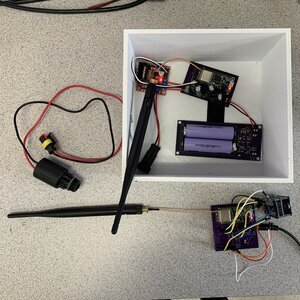
College of Engineering Unit:
The Wireless Solar Powered DC Valve Controller (WSPDVC) project is an irrigation control system designed for hobby farms. The system is designed to give small farmers better control over their irrigation watering schedules by automatically turning on their sprinklers based on watering schedule times input into a website.
The system is split into three main systems: the irrigation nodes, the control system, and the website. The irrigation nodes are powered by solar panels and control the DC solenoid valves that control water flow. The control system hub connects the website to the irrigation nodes and back, passing along watering schedules from the website and any errors from the irrigation nodes. Finally, the webserver connects to the control system hub and allows users to set new watering schedules, delete old ones, and see status updates from the irrigation nodes.
This is a project-partnerless project, meaning the team created all customer requirements by creating a pseudo-project partner and engineering requirements were then developed off of the pseudo-project partner customer requirements.
Engineering Requirements (ERs):
-
The system shall be powered directly by batteries and the batteries will be charged via a solar panel.
-
The system can communicate at least 600 ft.
-
The system creates customizable automatic watering schedules through a web interface.
-
The system adjusts the valve within 5 seconds of the scheduled time.
-
The system comes with a user guide.
-
The system sends messages through nodes with wireless communication systems that will successfully transmit 80% of sent messages.
-
The system records messages sent and received by the system to an internal data backup, holding a minimum of 1 month of messages.
-
The system circuitry will be protected by an enclosure that is water and dust-proof.
Design Process:
System design was split into 8 blocks, where each team member was in charge of the design and creation of two blocks. Interfaces between blocks were created before block design to ensure the blocks would be able to connect as smoothly as possible by predetermining inputs and outputs to each block, such as expected voltages and currents, data communication types, or message contents.
Each block owner then had time to design, prototype, and produce independently working blocks. During block design, each block only needed to fulfill its interfaces, with the designs being created to ultimately fulfill the 8 ERs once integrated together. Project integration occurred in Spring Term and consisted of taking the 8 independently developed blocks and combining them into a fully working system.
Future Recommendations:
Future teams that may pick up this project have many avenues they could pursue to improve upon this design.
-
Improved Website Design
Create website graphics that visually show information in some form of intuitive graphic as opposed to an updating table, such as a visual that shows when the watering schedule is active/inactive.
-
Backup Radio Protocol
The radio and WiFi communication provided the greatest challenge in the system. To avoid future difficulties, some kind of additional backup radio protocol would be useful in case the radio communication breaks down.
-
Additional Sensors
There are many potential sensors that could be integrated into the watering system to provide more use for farmers, such as a water sensor to measure flow rates and get better watering data or sensors to measure outside ambient temperatures or humidity.
Please check the Project Showcase link below and the accompanying artifacts for more information.
Project Website(s):
Project Communication Piece(s):
| Attachment | Size |
|---|---|
| 1.02 MB | |
| 8.34 MB |